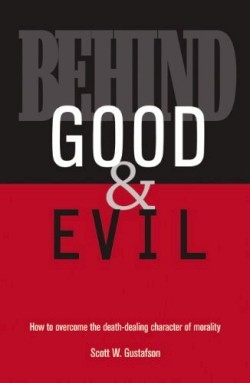Behind Good and Evil
How to Overcome the Death-dealing Character of Morality
“As fish do not know they are in water we cannot recognize the conditions in which we live” the author writes. “We think it is reasonable to return violence for violence.” We live our lives every day immersed in morality and ethics. In Behind Good and Evil pastor Scott W. Gustafson shows that there are only two basic paradigms within which we destroy or build relationships strive for dominance or cooperate destroy life or support it.
In this insightful volume Gustafson makes a distinction between morality and ethics describing the destructive dominating characteristics of morality and the life-supporting ways of partnership ethics. Gustafson’s well-documented illustrations cite historical examples and philosophy from around the world but draw heavily on the Bible as the Judeo-Christian experience is the most familiar to him. “Adam and Eve disobey” he writes. “They eat from the tree of the knowledge of good and evil and from that day forward humanity has not been able to understand anything except in terms of good and evil…compelled to understand everything in terms of good and evil better and best or bad and worse.”
Arbitrary ranking of everything has led to structuring our worldview in hierarchies of value power skill intelligence etc. The “haves” judge the “have nots” and justify themselves as those who are good and right even as they marginalize categorize isolate deprive and destroy the “evil” ones. They place themselves at the top of the hierarchy creating a moral divide and would rule the less endowed and defeat the evil enemies. But partnership ways “renounce the moral divide” identify with the marginalized support life cooperate instead of dominate show mercy instead of judgment.
This look at society speaks to the heart of Biblical understanding while also bridging the gap between religious and secular patterns of thought. Its insight provides profound ramifications for concepts of the nature of sin the Ten Commandments the beatitudes judgment repentance and confession; in fact “most of the Bible can be understood as a confrontation between these two world views.” We are steeped in morality but “it is possible to wake up from our moral slumber… It is difficult. It takes a great deal of discipline but it is not an impossible or hopeless task.” However Gustafson also warns “distinguishing between ethics and morality is not a safe academic enterprise. Those who call the established morality into question may risk their lives in doing so.”
Gustafson’s call to reevaluate morals and ethics is an insightful practical and far reaching manifesto for social change. It provides essential understanding for those who have been offended by religion as well as for Christians social reformers activists philosophers politicians peacemakers and average joes. This book will change lives.
Disclosure: This article is not an endorsement, but a review. The publisher of this book provided free copies of the book and paid a small fee to have their book reviewed by a professional reviewer. Foreword Reviews and Clarion Reviews make no guarantee that the publisher will receive a positive review. Foreword Magazine, Inc. is disclosing this in accordance with the Federal Trade Commission’s 16 CFR, Part 255.

